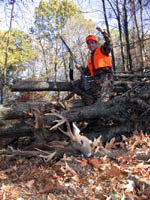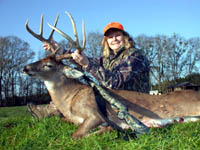
|
Features
|
|
|
|
Books
|
|
|
|
Fun & Games
|
|
|
|
Contact Us
|
|
|
John's Journal... Entry 222, Day 4
FIVE MOST CRITICAL INGREDIENTS FOR BAGGING A BUCK WITH A GUN
Dr. Keith Causey -- Food
 Editor's
Note: The five most-critical ingredients for taking a buck with your gun
at any time during the season include the wind, the weather, hunting pressure,
food availability and the rut. Most hunters will tell you one of these
factors has more importance to successful deer hunting than any other
element. However, you'll need to consider all these ingredients to develop
a successful hunt plan. This week we'll talk with some of the nation's
best gun hunters about their ideas. For more than three decades, Dr. Keith
Causey, a professor of wildlife science at Auburn University in Auburn,
Alabama, has researched the white-tailed deer, specifically on the role
food plays in the life cycle of the deer.
Editor's
Note: The five most-critical ingredients for taking a buck with your gun
at any time during the season include the wind, the weather, hunting pressure,
food availability and the rut. Most hunters will tell you one of these
factors has more importance to successful deer hunting than any other
element. However, you'll need to consider all these ingredients to develop
a successful hunt plan. This week we'll talk with some of the nation's
best gun hunters about their ideas. For more than three decades, Dr. Keith
Causey, a professor of wildlife science at Auburn University in Auburn,
Alabama, has researched the white-tailed deer, specifically on the role
food plays in the life cycle of the deer.
 Research
suggests that deer select the food they eat based on the nutritional value
of that food. In one study, researchers planted a green field in wheat
and rye. The middle of the field received fertilizer while the outer edges
of the field remained untouched. Deer walked through the unfertilized
wheat and rye to reach the fertilized crop. Most hunters know you can
plant green fields and properly lime and fertilize them to create a winter-feeding
site for deer. However, many sportsmen don't realize you can fertilize
naturally-occurring plants and often attract as many if not more deer.
On the property I hunt, I fertilize blackberry bushes, Japanese honeysuckle
and newly-cleared fields to produce lush foliage containing more protein
than unfertilized plants. The deer always will feed on the fertilized
plants. You can put out fertilizer any place where you have a cleared
field. Then the naturally occurring plants in the cleared field will yield
more lush foliage than other plants growing in the field. If you hunt
large clear-cuts, fertilize blackberry bushes and honeysuckle plants on
one side of the clear-cut. Then take a stand near the area you fertilize.
I also fertilize certain trees like plums and persimmons for early-season
hunting and selected white oak and red oak for late-season hunting. I
know the trees I fertilize put on more and larger acorns than the trees
I don't fertilize. Although I can't prove my idea scientifically, I believe
deer feed on the acorns under the fertilized trees more heavily -- either
because these acorns taste better or perhaps have more nutritional value.
Or, maybe the deer have to eat less of these acorns than the smaller acorns
to feel satisfied. Food also helps determine the size of bucks you have
to hunt. The more high-quality food available for both bucks and does
to feed on, the better a buck's rack will be and the heavier his body
weight. This fertilizing program will increase any hunter's odds of bagging
a buck. Therefore you need to:
Research
suggests that deer select the food they eat based on the nutritional value
of that food. In one study, researchers planted a green field in wheat
and rye. The middle of the field received fertilizer while the outer edges
of the field remained untouched. Deer walked through the unfertilized
wheat and rye to reach the fertilized crop. Most hunters know you can
plant green fields and properly lime and fertilize them to create a winter-feeding
site for deer. However, many sportsmen don't realize you can fertilize
naturally-occurring plants and often attract as many if not more deer.
On the property I hunt, I fertilize blackberry bushes, Japanese honeysuckle
and newly-cleared fields to produce lush foliage containing more protein
than unfertilized plants. The deer always will feed on the fertilized
plants. You can put out fertilizer any place where you have a cleared
field. Then the naturally occurring plants in the cleared field will yield
more lush foliage than other plants growing in the field. If you hunt
large clear-cuts, fertilize blackberry bushes and honeysuckle plants on
one side of the clear-cut. Then take a stand near the area you fertilize.
I also fertilize certain trees like plums and persimmons for early-season
hunting and selected white oak and red oak for late-season hunting. I
know the trees I fertilize put on more and larger acorns than the trees
I don't fertilize. Although I can't prove my idea scientifically, I believe
deer feed on the acorns under the fertilized trees more heavily -- either
because these acorns taste better or perhaps have more nutritional value.
Or, maybe the deer have to eat less of these acorns than the smaller acorns
to feel satisfied. Food also helps determine the size of bucks you have
to hunt. The more high-quality food available for both bucks and does
to feed on, the better a buck's rack will be and the heavier his body
weight. This fertilizing program will increase any hunter's odds of bagging
a buck. Therefore you need to:
* determined the types of food deer will feed on in your area throughout
hunting season.
* fertilize specific regions containing that kind of food for early-,
middle- and late-season hunting.
* hunt the trails going to the fertilized food source.
* hunt within shooting distance of that food source.
TOMORROW: RONNIE GROOM -- THE RUT
Check back each day this week for more about FIVE MOST CRITICAL INGREDIENTS FOR BAGGING A BUCK WITH A GUN...
Day 1 - Notice The Wind
With Dick Kirby
Day 2 - Bob Walker On Weather
Day 3 - David Hale -- Hunting Pressure
Day 4 - Dr. Keith Causey -- Food
Day 5 - Ronnie Groom -- The Rut